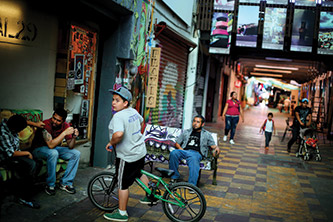Modern Languages and Literatures: Border Writers
For many, Tijuana is not aesthetically pretty. With a population of 1.3 million people, it is grimy and loud, as with any large city, and lacks the colonial architecture or history found across Mexico’s interior. The growth of Tijuana is recent, but the city’s magnificence lies deeper and is brought to surface by writers living here. The work of four Tijuana authors is the focus of research by Miguel Pillado.
Pillado, assistant professor of Spanish in the department of modern languages and literatures, analyzes work by authors who challenge the stereotypical images of the city.
“We’re talking about images being produced, both in Mexico and the United States, of Tijuana as a city of vice or Tijuana as a city of transit, where migrants pass to get to the United States,” he says. “There is a more recent metaphor to talk about this city and that is to talk about Tijuana as a cultural hybrid entity, an emblem of the postmodern world. “
He is exploring images of the city through the literature of these local writers. He examines the works of four authors he terms fronterizo writers—Federico Campbell, Luis Humberto Crosthwhite, Rosina Conde and Heriberto Yépez. Each writer brings to his or her work a unique perspective of Tijuana’s cultural and social panorama. Yet, together they demonstrate that Tijuana has problems, such as social and economic inequality, issues that can be translated to any other large city in the world, says Pillado.
“Some of them want to explore issues of gender, in the case of Rosina Conde, while others explore issues of ethnic encounters in the city. The multiplicity of the character of this city challenges the stereotypes that tend to simplify reality. These writers talk about the dynamic identities of the people who live along the border and the border experience. They don’t invert the totalizing metaphors about the city, but rather elevate them to levels of complexities that go beyond their oversimplifying nature. They do this by emphasizing the narratives of the people who live in this place, whose lives are diverse as well.”
Posted on:


